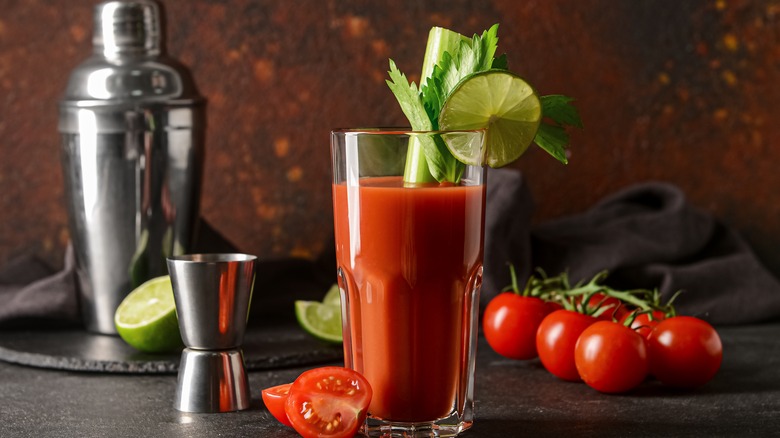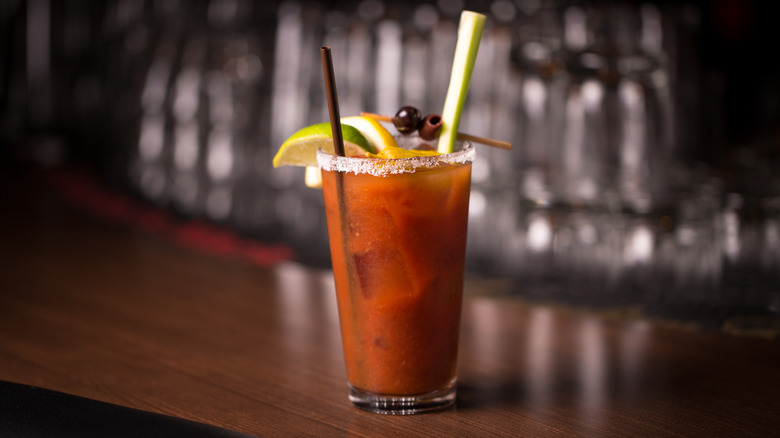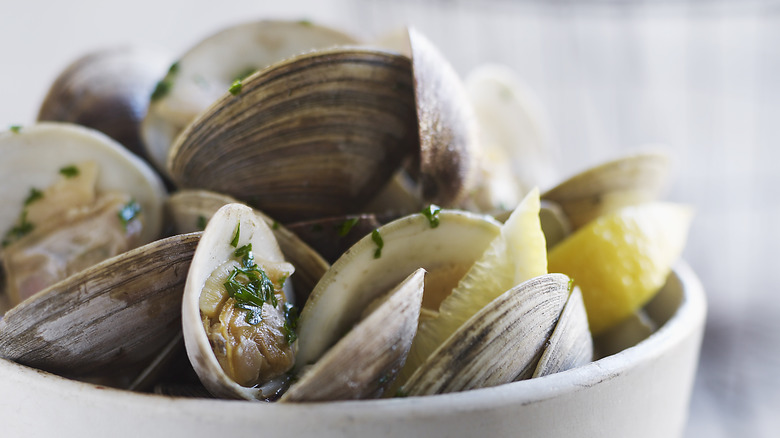What's The Real Difference Between A Bloody Mary And A Bloody Caesar?
Touted as a magical hangover cure, the Bloody Mary is an iconic cocktail and staple of many extended brunch outings. This tasty drink is chockful of complex flavors, and also features a variety of delicious garnishes. According to Grey Goose, a classic Bloody Mary must include certain core ingredients. In addition to the vodka and tomato juice base, the recipe also features savory Worcestershire sauce, salt and pepper, tangy lemon juice, horseradish for zing, and a splash of hot sauce. As for garnishes, a Bloody Mary just isn't the same without a stalk of celery and a few olives bobbing around.
Like most popular cocktails, people love tweaking the Bloody Mary recipe to make it their own. For instance, some prefer to garnish their drink with crispy bacon or incorporate flavored vodka into the base. And one variation proved so popular that it even got its own name: The Bloody Caesar. This spin on the classic concoction made a name for itself thanks to the inclusion of one surprising ingredient. Despite their differences, both cocktails have very interesting, if not hotly debated, origins.
The Bloody Mary's convoluted history
As explained by Difford's Guide, at least two people claim to have "invented" the Bloody Mary. Fernand Petiot, a French bartender working in Paris, claimed to have created the cocktail there and brought it to America. However, evidence indicates that the cocktail's credit actually goes to American actor George Jessel in 1927.
Career, aside, Jessel was an enthusiastic drinker and once found himself on the wrong side of a hangover after imbibing all night, which was a problem considering he had an early morning volleyball match. Jessel was introduced to vodka by a bartender as a potential cure. Vodka was still relatively unknown in America, and Jessel was put off by the aroma. As the legend goes, he added ingredients that he hoped would mask the smell, downed the drink, and began to feel better.
The origins of the Bloody Mary may be disputed, but the popularity of the drink is not. With many variations popping up through the years, including the Bloody Maria and Michelada, Canada's answer to the Bloody Mary, might be the most coveted. Known as the Bloody Caesar, this cocktail has a similarly contested origin story with lots of boozy appeal.
Canada's spin on a classic recipe
According to NYT Cooking, the Canadian-based Bloody Caesar contains most of the same ingredients as the Bloody Mary. The big difference lies in the inclusion of clam-tomato juice, or clamato juice to those in the know. Much like its big sister, the Bloody Caesar is a wildly popular cocktail with a reputation for being a tried-and-true hangover cure. As explained by Vice, estimates indicate that more than 350 million Bloody Caesars are consumed by Canadians annually. That means the drink is as synonymous with Canada as poutine, Timbits, and maple syrup.
As for its origins, Liquor.com states that the cocktail was developed by Walter Chell in Alberta, Canada during the late 1960s. At that time, the owners of the Calgary bar Chell managed were launching a new Italian restaurant and wanted a cocktail recipe to go with it. Using fresh seafood as an inspiration, Chell added clam juice to the standard Bloody Mary recipe (in this case, tomato juice, vodka, Tabasco, and Worcestershire sauce). Much like Petiot and Jessel, Chell is somewhat disputed as the true inventor of the drink. Similar drink recipes were recorded years before Chell threw his hat into the ring, which just proves that crafting a classic cocktail is often a collaborative effort.


